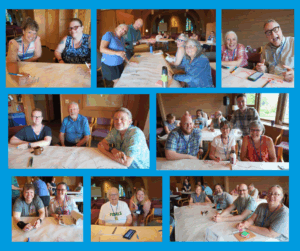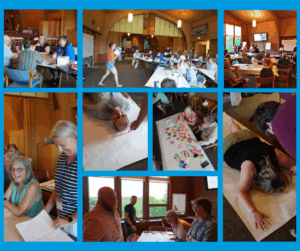Written by Geoffrey Gill a reflection of our Sustainability Retreat in June 2025.
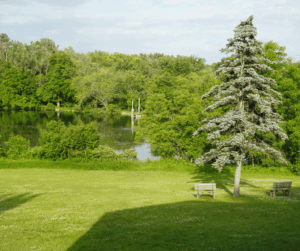 “Rivers carved stones, not by force, but by showing up day after day until Earth remembers.”
“Rivers carved stones, not by force, but by showing up day after day until Earth remembers.”
We went to Dunrovin Retreat Center in St. Croix with four intentions: slow down together, encourage through reflection, dream about the future, and claim our next right work.
What happened was we actually did those things. Not the polite version. The real version.
The Ground We Broke
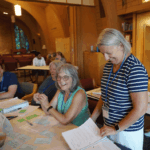 Picture this: teams scattered around tables, sharing their stories – not the clean sanitized versions they tell at board meetings, but the messy truth. The breakthroughs mixed with grief. The celebrations tangled up with the spaces where they’re stuck.
Picture this: teams scattered around tables, sharing their stories – not the clean sanitized versions they tell at board meetings, but the messy truth. The breakthroughs mixed with grief. The celebrations tangled up with the spaces where they’re stuck.
Someone said the word “ecosystem” and suddenly we weren’t talking about neighborhoods as problems to solve anymore. We were talking about soil – what feeds growth, what determines what can actually take root. Climate – the forces that decide who belongs. Water – the relationships that connect everything, and what happens when they dry up.
Then we walked outside.
When the Trail Became Teacher
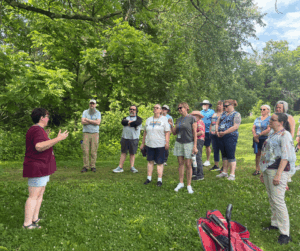 There’s something that happens when you stop theorizing about interconnection and start looking at it. Actual roots. Actual water flow. Actual evidence of what thrives and what doesn’t, and why.
There’s something that happens when you stop theorizing about interconnection and start looking at it. Actual roots. Actual water flow. Actual evidence of what thrives and what doesn’t, and why.
Standing there in the heat that made us grateful for shade, pointing at trees that couldn’t survive without the fungi they’re connected to, talking about how nutrients in soil literally determine what grows – the metaphor stopped being a metaphor.
We came back inside with dirt on our shoes and feet – some people had taken their shoes off to ground themselves in the earth – and something shifted in our bodies.
The Moment Everything Got Uncomfortable
 Arts and crafts materials everywhere. Big sheets of paper. Cut-out trees and clouds and rocks. People mapping their actual communities – the power holders, the connectors, the resistance, the beautiful mess of how things really work.
Arts and crafts materials everywhere. Big sheets of paper. Cut-out trees and clouds and rocks. People mapping their actual communities – the power holders, the connectors, the resistance, the beautiful mess of how things really work.
Then someone asked about invasive species.
The room went quiet. Because suddenly we had to name things. Put labels on community groups. Say out loud what we usually only think privately. The discomfort was thick enough to touch.
And instead of managing that tension away, we stayed with it. Let it teach us something about the difference between comfortable conversations and honest ones. About how growth happens when we finally look at what we usually can’t bear to see.
Bodies as Maps
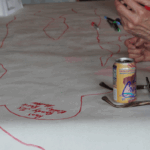 Someone literally laid down on paper and let themselves be traced. Their body became the template for understanding how their church actually works.
Someone literally laid down on paper and let themselves be traced. Their body became the template for understanding how their church actually works.
Brain – the visionaries and tactical thinkers. Heart – the compassionate ones. Hands – the church basement ladies who get things done. Muscles – the power holders. Digestive system – yes, we actually assigned the opposition folks to the digestive system, and somehow that made sense. Feet – the neighborhood connectors, the door kickers, the ones who make things happen on the ground.
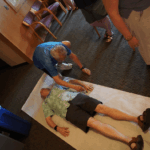 Watching people write and draw in different areas of that traced body, figuring out where the blockages are, where the energy flows, where things are disconnected – it was like watching surgery on community itself.
Watching people write and draw in different areas of that traced body, figuring out where the blockages are, where the energy flows, where things are disconnected – it was like watching surgery on community itself.
The Truth About Change
We worked with the change formula – looking at dissatisfaction with how things are, vision for what’s possible, and actual first steps we could take, weighing all of that against the resistance, reluctance, and fear.
The question wasn’t whether resistance exists – of course it does. The question was whether our pain plus hope plus action could outweigh it.
Some people’s next right action was grief. Some needed rest. Some needed to step back for conversations they’d been avoiding. The work honored that instead of pushing everyone toward the same action steps.
What We Took Home
In the closing circle, people shared what they were taking with them. Not platitudes or good intentions, but specific clarity about what God was preparing them to become. What their next right work actually was. Where they located themselves in all of this.
We sang “Build a Longer Table” before we left. Voices mixing in the air, carrying something we’d built together back out into the world.
The Transmission
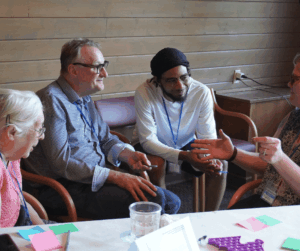 Here’s what I want you to know: this level of authentic community work is possible.
Here’s what I want you to know: this level of authentic community work is possible.
Not the version where everyone’s polite and nothing really changes. The version where people cry and laugh and name uncomfortable truths and trace each other’s bodies on paper and intense conversations about invasive species and come out the other side more connected, more clear, more ready for whatever comes next.
The version where you stop managing tension and let it carve new channels, like rivers working on stone.
It requires showing up day after day, creating containers strong enough to hold what wants to emerge. It requires facilitators who know how to ground a room when things get shaky. It requires trusting that communities can handle their own truth when they’re held well enough.
But it’s possible. We know because we did it.
The people in that room walked away different than they came. Not because someone fixed them or gave them the right strategy, but because they did the work of seeing clearly – themselves, their communities, their ecosystems – and discovered they could bear more truth and see more possibility than they thought.
That’s the kind of sustainability that actually sustains: not the kind you implement, but the kind you become.
